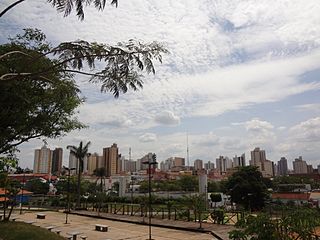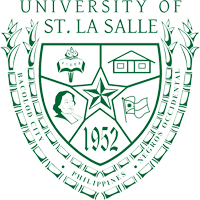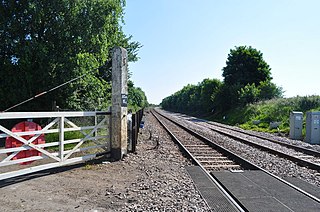
East Lancashire Railway is a 12+1⁄2-mile (20 km) heritage railway line in North West England which runs between Heywood, Greater Manchester and Rawtenstall in Lancashire. There are intermediate stations at Bury Bolton Street, Burrs Country Park, Summerseat and Ramsbottom, with the line crossing the border into Rossendale serving Irwell Vale and Rawtenstall. Before closure, the line terminated at Bacup.

Barretos is a municipality in the northern part of the state of São Paulo, Brazil. The city has approximately 122,833 inhabitants (IBGE/2020) and an area of 1566.1 km². Barretos belongs to the Mesoregion of Ribeirão Preto.

Mato Grosso do Sul is one of the Midwestern states of Brazil. Neighboring Brazilian states are Mato Grosso, Goiás, Minas Gerais, São Paulo and Paraná. It also borders the countries of Paraguay, to the southwest, and Bolivia, to the west. The economy of the state is largely based on agriculture and cattle-raising. Crossed in the south by the Tropic of Capricorn, Mato Grosso do Sul generally has a warm, sometimes hot, and humid climate, and is crossed by numerous tributaries of the Paraná River. The state has 1,3% of the Brazilian population and is responsible for 1,5% of the Brazilian GDP.

The ISU-122 was a Soviet assault gun used during World War II, mostly in the anti-tank role.

The Ecclesbourne Valley Railway is a 9-mile (14.5 km) long heritage railway in Derbyshire. The headquarters of the railway centre on Wirksworth station, and services operate in both directions between Wirksworth and Duffield and from Wirksworth to Ravenstor.

Catanduva is a municipality in the state of São Paulo, Brazil. The population is 122,497 in an area of 290.59 km2. Is the second largest city in the Northern part of the state, after São José do Rio Preto. The city has a diversified economy, and the cultivation and processing of sugarcane is relevant.

Divinópolis is a municipality in the centre-west of Minas Gerais state, Brazil. The estimated population in 2020 was 240,408 inhabitants. The total area of the municipality is 709 km² and the elevation is 712 metres. It is 120 km from state capital Belo Horizonte. Divinópolis is the seat of the Regional Administration of the Upper São Francisco River.

Turvânia is a municipality in eastern Goiás state, Brazil.

The University of St. La Salle (USLS) is a Catholic private research university run by the De La Salle Brothers, located in La Salle Avenue, Bacolod City, Negros Occidental, Philippines. Established in 1952 as La Salle College - Bacolod, it is the second oldest campus founded by the congregation in the country. The university is a member of De La Salle Philippines, a network established in 2006 comprising 16 Lasallian educational institutions in the Philippine islands. The university offers preschool, elementary, secondary, undergraduate, and graduate programs. It has seven colleges namely: Business and Accountancy, Engineering and Technology, Arts and Sciences, Education, Nursing, Law, and Medicine.

Indium(III) bromide, (indium tribromide), InBr3, is a chemical compound of indium and bromine. It is a Lewis acid and has been used in organic synthesis.

Banksia shuttleworthiana, commonly known as bearded dryandra, is a species of low, spreading shrub that is endemic to Western Australia. It has thin, woolly-hairy stems, linear pinnatisect leaves, creamy brown to purplish flowers in heads of about forty and later, only a few egg-shaped follicles in each head.

Banksia stenoprion is a species of prostrate shrub that is endemic to the south-west of Western Australia. It has short, underground stems, pinnatisect leaves with triangular lobes, golden, mauve or purple flowers in heads of up to ninety, and egg-shaped follicles.
Banksia tortifolia is a small, spreading, prostrate shrub that is endemic to the southwest of Western Australia. It has short underground stems, pinnatipartite leaves with sharply-pointed, linear lobes on each side, greenish-cream, yellow and pink flowers in heads of about eighty, and glabrous, egg-shaped follicles.
An enzyme-linked receptor, also known as a catalytic receptor, is a transmembrane receptor, where the binding of an extracellular ligand causes enzymatic activity on the intracellular side. Hence a catalytic receptor is an integral membrane protein possessing both enzymatic, catalytic, and receptor functions.
Bromoiodomethane is a halomethane with the formula BrCH2I. It is a colorless liquid, although older samples appear yellow. The compound has been investigated as a reagent for cyclopropanation by the Simmons-Smith reaction, but diiodomethane and chloroiodomethane are preferred. It also occurs naturally as the result of microbial action.

Spink's Lane was a railway station in Wymondham. It was opened very briefly in 1845 to trains on the line from Norwich.
The APG III system of flowering plant classification is the third version of a modern, mostly molecular-based, system of plant taxonomy being developed by the Angiosperm Phylogeny Group (APG). Published in 2009, it was superseded in 2016 by a further revision, the APG IV system.

Chromium(III) bromide is an inorganic compound with the chemical formula CrBr3. It is a dark colored solid that appears green in transmitted light but red with reflected light. It is used as a precursor to catalysts for the oligomerization of ethylene.















